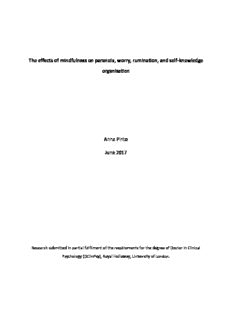
The effects of mindfulness on paranoia, worry, rumination, and self-knowledge organisation Anna ... PDF
Preview The effects of mindfulness on paranoia, worry, rumination, and self-knowledge organisation Anna ...
The effects of mindfulness on paranoia, worry, rumination, and self-knowledge organisation Anna Pinto June 2017 Research submitted in partial fulfilment of the requirements for the degree of Doctor in Clinical Psychology (DClinPsy), Royal Holloway, University of London. Acknowledgements I would like to thank my supervisors, Dr Lyn Ellett and Dr Jane Vosper, for their support, prompt communication, and guidance throughout the study. I would also like to thank all the participants for their time and commitment during their participation in the study. I am also particularly thankful to Charlotte, my research partner, whose support throughout the study has been invaluable. A special thanks to my family, friends, and Michalis for their unconditional support, love, and understanding over the years. 2 Abstract Paranoia, one of the positive symptoms of psychosis, is also highly prevalent and distressing in non-clinical populations which suggests that clinical paranoia exists on a continuum with non-clinical paranoia. Psychological interventions are therefore needed for distressing non- clinical paranoia and as an analogue for clinical paranoia. Mindfulness interventions that use Insight Meditation (IM), which focuses on observation and acceptance of internal experiences in a non-judgemental way while maintaining a focus on breathing, have shown promising effects in psychosis. Two preliminary studies suggest that Loving Kindness Meditation (LKM), which focuses on increasing social connection and kindness toward oneself and others, is effective for negative symptoms of psychosis. However, little is known about the effects of mindfulness interventions on non-clinical paranoia and its associated processes. Moreover, no study to date has compared IM to LKM in clinical or non-clinical paranoia. The current study used a randomised design to compare the effects of IM and LKM on paranoia outcomes (i.e. frequency of paranoid thoughts, associated distress, and state paranoia), on processes associated with paranoia (i.e. worry, rumination, repetitive negative thinking), and on a self- related process that is proposed to be relevant to paranoia, that is self-knowledge compartmentalisation. One hundred individuals from a non-clinical population who scored high on measures of trait paranoia and paranoia distress were randomised to practise either IM or LKM for 14 days. Outcomes were measured pre-intervention, post-intervention, and at 1-month follow-up. No significant differences were found between LKM and IM on the examined outcomes. Both mindfulness conditions showed highly significant improvements on all the outcomes from baseline to post-intervention, with the effects remaining highly 3 significant at 1-month follow-up. The effect sizes were large for paranoia outcomes, medium for worry, rumination and repetitive negative thinking, and small for self-knowledge compartmentalisation. The findings demonstrate the potential of IM and LKM as psychological interventions for distressing non-clinical paranoia. They also highlight the importance of verifying their effectiveness for persecutory delusions. 4 List of tables Table 1: Demographics & Baseline Covariate Variables .......................................................... 70 Table 2: Outcome variables ..................................................................................................... 73 List of figures Figure 1: Rationale for the relevance of mindfulness for psychotic experiences (from Chadwick et al. 2005) ............................................................................................................................... 29 Figure 2: CONSORT diagram of participant flow through the study stages ............................ 68 5 Contents 1 Introduction ..................................................................................................................... 11 1.1 Overview .................................................................................................................. 11 1.2 Non-clinical paranoia ............................................................................................... 12 1.2.1 Definition of paranoia ...................................................................................... 12 1.2.2 Prevalence of non-clinical paranoia ................................................................. 13 1.2.3 Psychological distress associated with non-clinical paranoia .......................... 15 1.2.4 Processes associated with non-clinical paranoia ............................................. 16 1.2.5 Summary .......................................................................................................... 26 1.3 Mindfulness interventions for paranoia .................................................................. 27 1.3.1 Definition of Mindfulness ................................................................................ 27 1.3.2 Mindfulness interventions for psychosis ......................................................... 27 1.3.3 Mindfulness interventions for clinical paranoia .............................................. 32 1.3.4 Mindfulness interventions for non-clinical paranoia ....................................... 33 1.3.5 Insight Meditation versus Loving Kindness Meditation ................................... 35 1.3.6 Comparison of Insight Meditation to Loving Kindness Meditation ................. 38 1.4 Paranoia-related processes and mindfulness .......................................................... 41 1.4.1 A worry thinking style ...................................................................................... 42 1.4.2 Self-related processes ...................................................................................... 44 6 1.5 Gaps in the literature ............................................................................................... 46 1.6 Present study............................................................................................................ 47 2 Methods ........................................................................................................................... 49 2.1 Overview .................................................................................................................. 49 2.2 Design ....................................................................................................................... 49 2.3 Sample ...................................................................................................................... 50 2.3.1 Inclusion Criteria ............................................................................................... 50 2.3.2 Power analysis .................................................................................................. 50 2.3.3 Recruitment ...................................................................................................... 51 2.4 Variables and Measures ........................................................................................... 52 2.4.1 Phase 1 Variables - Screening ........................................................................... 52 2.4.2 Phase 2 Variables - Intervention....................................................................... 53 2.4.3 Measures .......................................................................................................... 53 2.5 Piloting...................................................................................................................... 58 2.6 Procedure ................................................................................................................. 59 2.6.1 Phase 1 - Screening ........................................................................................... 59 2.6.2 Phase 2 - Intervention ...................................................................................... 60 2.6.3 Randomisation .................................................................................................. 61 2.7 Mindfulness Conditions............................................................................................ 61 7 2.8 Ethics ........................................................................................................................ 62 3 Results ............................................................................................................................. 64 3.1 Overview .................................................................................................................. 64 3.2 Data checking and cleaning ..................................................................................... 64 3.2.1 Missing data ..................................................................................................... 65 3.2.2 Outliers ............................................................................................................. 65 3.2.3 Normality of distribution ................................................................................. 66 3.3 Sample ..................................................................................................................... 67 3.3.1 Sample characteristics ..................................................................................... 69 3.3.2 Comparison of study completers and drop-outs ............................................. 71 3.4 Main analysis ........................................................................................................... 72 3.4.1 Hypothesis I ...................................................................................................... 74 3.4.2 Hypothesis II ..................................................................................................... 76 3.4.3 Hypothesis III .................................................................................................... 77 4 Discussion ........................................................................................................................ 79 4.1 Overview .................................................................................................................. 79 4.2 Main findings ........................................................................................................... 80 4.2.1 The effects of Loving Kindness Meditation and Insight Meditation on paranoia frequency, paranoia distress, and state paranoia ........................................................... 80 8 4.2.2 The effects of Loving Kindness Meditation and Insight Meditation on worry, rumination, and repetitive negative thinking .................................................................. 87 4.2.3 The effects of Loving Kindness Meditation and Insight Meditation on self- knowledge compartmentalisation ................................................................................... 90 4.2.4 Amount of meditation practice ........................................................................ 92 4.2.5 Participant engagement with the meditations ................................................ 93 4.3 Clinical implications .................................................................................................. 94 4.4 Strengths and limitations ......................................................................................... 98 4.4.1 Study strengths ................................................................................................. 98 4.4.2 Study limitations ............................................................................................. 101 4.5 Future research ...................................................................................................... 104 4.6 Conclusions............................................................................................................. 107 References ............................................................................................................................. 109 Appendices ............................................................................................................................ 127 Appendix 1: Study Poster ...................................................................................................... 127 Appendix 2: Script of Advertisement for Social Media ......................................................... 128 Appendix 3: Study Measures ................................................................................................. 129 Appendix 4: Information Sheet ............................................................................................. 142 Appendix 5: Consent Form .................................................................................................... 146 9 Appendix 6: Debrief Form ..................................................................................................... 147 Appendix 7: Mindfulness Practice Diary ............................................................................... 149 Appendix 8: RHUL Ethics Committee Approval Notifications ............................................... 150 10
Description: